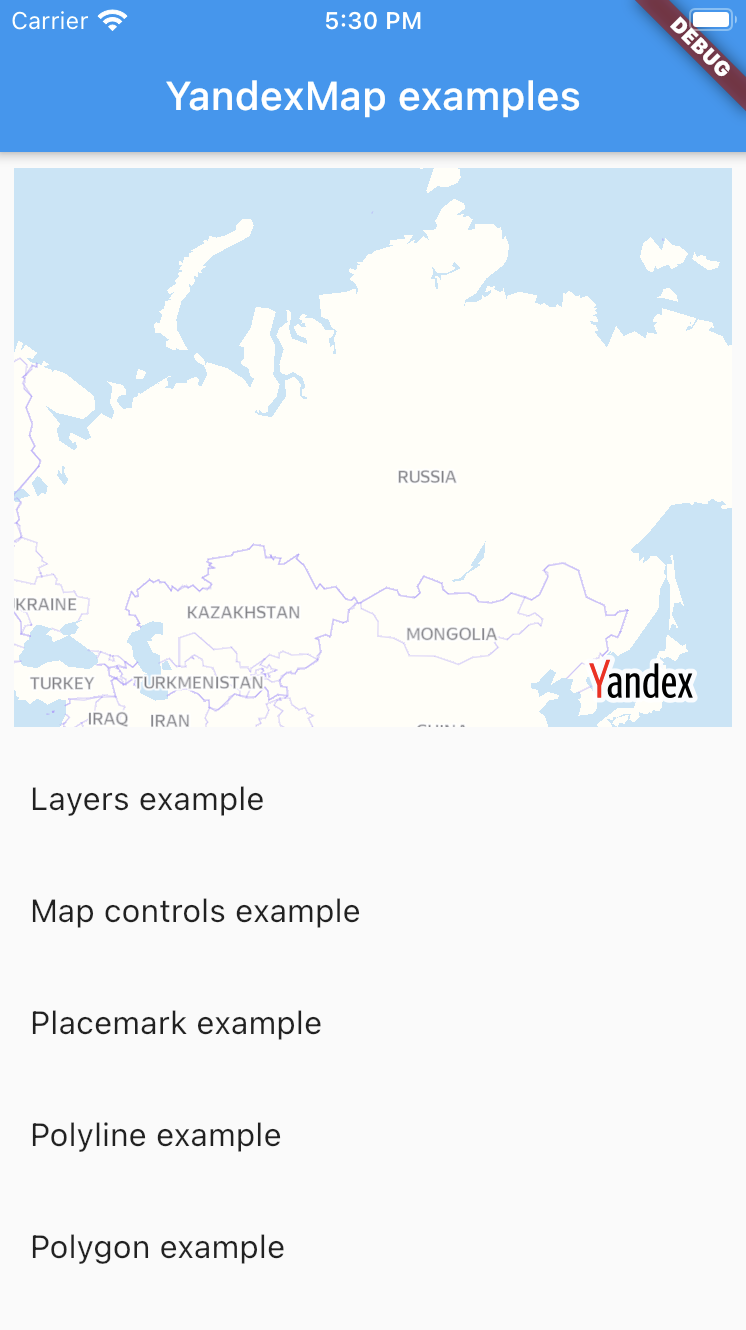yandex_mapkit_lite
Description
This library is a fork of the package yandex_mapkit 3.4.0. Features such as Suggestions, Search, ReverseSearch, Bicycle, Driving have been removed from it.
Add somewhere in the description that the lite version of Yandex maps is used on the native side of the connection. This version of the map can reduce the size of the application by an average of 30%.
Features
XWorking with Placemarks/Polylines/Polygons/Circles - adding, updating, removing, tap events, stylingXWorking with collections of map objectsXWorking with clustersXMoving around the mapXSetting map boundsXShowing current user locationXStyling the mapXWorking with geo objects
Removed:
XAddress suggestionsXBasic driving/bicycle routingXBasic address direct/reverse searchXShowing current traffic conditions
❗️If you need all the features, we recommend using the original package yandex_mapkit
A flutter plugin for displaying yandex maps on iOS and Android.
| Android | iOS | |
|---|---|---|
| Support | SDK 21+ | iOS 12+ |
Disclaimer: This project uses Yandex Mapkit which belongs to Yandex
When using Mapkit refer to these terms of use
Installation
Add yandex_mapkit_lite to your pubspec.yaml file:
dependencies:
yandex_mapkit_lite: $currentVersion$
Getting Started
Generate your API Key
- Go to https://developer.tech.yandex.ru/services/
- Create a
MapKit Mobile SDKkey
Setup for iOS
- Specify your API key and locale in
ios/Runner/AppDelegate.swift. It should be similar to the following
import UIKit
import Flutter
import YandexMapsMobile
@UIApplicationMain
@objc class AppDelegate: FlutterAppDelegate {
override func application(
_ application: UIApplication,
didFinishLaunchingWithOptions launchOptions: [UIApplication.LaunchOptionsKey: Any]?
) -> Bool {
YMKMapKit.setLocale("YOUR_LOCALE") // Your preferred language. Not required, defaults to system language
YMKMapKit.setApiKey("YOUR_API_KEY") // Your generated API key
GeneratedPluginRegistrant.register(with: self)
return super.application(application, didFinishLaunchingWithOptions: launchOptions)
}
}
- Uncomment
platform :ios, '9.0'inios/Podfileand change toplatform :ios, '12.0'
# Uncomment this line to define a global platform for your project
platform :ios, '12.0'
Setup for Android
- Add dependency
implementation 'com.yandex.android:maps.mobile:4.4.0-full'toandroid/app/build.gradle
dependencies {
implementation 'com.yandex.android:maps.mobile:4.4.0-full'
}
- Specify your API key and locale in your custom application class.
If you don't have one the you can create it like so
android/app/src/main/.../MainApplication.java
import android.app.Application;
import com.yandex.mapkit.MapKitFactory;
public class MainApplication extends Application {
@Override
public void onCreate() {
super.onCreate();
MapKitFactory.setLocale("YOUR_LOCALE"); // Your preferred language. Not required, defaults to system language
MapKitFactory.setApiKey("YOUR_API_KEY"); // Your generated API key
}
}
android/app/src/main/.../MainApplication.kt
import android.app.Application
import com.yandex.mapkit.MapKitFactory
class MainApplication: Application() {
override fun onCreate() {
super.onCreate()
MapKitFactory.setLocale("YOUR_LOCALE") // Your preferred language. Not required, defaults to system language
MapKitFactory.setApiKey("YOUR_API_KEY") // Your generated API key
}
}
- In your
android/app/src/main/AndroidManifest.xml
Add permissions <uses-permission android:name="android.permission.INTERNET"/> and <uses-permission android:name="android.permission.ACCESS_FINE_LOCATION"/>
Find application tag and replace android:name to the name of your custom application class prefixed by a dot ..
In the end it should look like the following
<uses-permission android:name="android.permission.INTERNET"/>
<uses-permission android:name="android.permission.ACCESS_FINE_LOCATION" />
<application
android:name=".MainApplication" >
Example
For usage examples refer to example app

Additional remarks
YandexMapkit always works with one language only.
Due to native constraints after the application is launched it can't be changed.
Android
Hybrid Composition
By default android views are rendered using Hybrid Composition.
To render the YandexMap widget on Android using Virtual Display(old composition), set AndroidYandexMap.useAndroidViewSurface to false.
Place this anywhere in your code, before using YandexMap widget.
AndroidYandexMap.useAndroidViewSurface = false;

